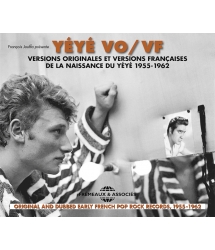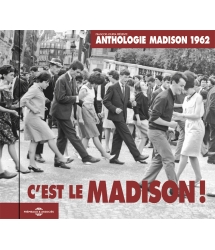- Notre Catalogue
- Philosophie
- Philosophes du XXème siècle et d'aujourd'hui
- Histoire de la philosophie (PUF)
- Contre-Histoire et Brève encyclopédie par Michel Onfray
- L'œuvre philosophique expliquée par Luc Ferry
- La pensée antique
- Les penseurs d'hier vus par les philosophes d'aujourd'hui
- Textes philosophiques historiques interprétés par de grands comédiens
- Histoire
- Livres
- Sciences Humaines
- Paroles historiques
- Livres audio & Littérature
- Notre Catalogue
- Jazz
- Blues - R'n'B - Soul - Gospel
- Rock - Country - Cajun
- Chanson française
- Musiques du monde
- Afrique
- France
- Québec / Canada
- Hawaï
- Antilles
- Caraïbes
- Cuba & Afro-cubain
- Mexique
- Amérique du Sud
- Tango
- Brésil
- Tzigane / Gypsy
- Fado / Portugal
- Flamenco / Espagne
- Yiddish / Israël
- Chine
- Tibet / Népal
- Asie
- Océan indien / Madagascar
- Japon
- Indonésie
- Océanie
- Inde
- Bangladesh
- URSS / Chants communistes
- Musiques du monde / Divers
- Musique classique
- Compositeurs - Musiques de film - B.O.
- Sons de la nature
- Notre Catalogue
- Jeunesse
- Philosophie
- Nouveautés
- Comment commander ?
- Recevoir le catalogue
- Manifeste
- Dictionnaire











- Notre Catalogue
- Philosophie
- Philosophes du XXème siècle et d'aujourd'hui
- Histoire de la philosophie (PUF)
- Contre-Histoire et Brève encyclopédie par Michel Onfray
- L'œuvre philosophique expliquée par Luc Ferry
- La pensée antique
- Les penseurs d'hier vus par les philosophes d'aujourd'hui
- Textes philosophiques historiques interprétés par de grands comédiens
- Histoire
- Livres
- Sciences Humaines
- Paroles historiques
- Livres audio & Littérature
- Notre Catalogue
- Jazz
- Blues - R'n'B - Soul - Gospel
- Rock - Country - Cajun
- Chanson française
- Musiques du monde
- Afrique
- France
- Québec / Canada
- Hawaï
- Antilles
- Caraïbes
- Cuba & Afro-cubain
- Mexique
- Amérique du Sud
- Tango
- Brésil
- Tzigane / Gypsy
- Fado / Portugal
- Flamenco / Espagne
- Yiddish / Israël
- Chine
- Tibet / Népal
- Asie
- Océan indien / Madagascar
- Japon
- Indonésie
- Océanie
- Inde
- Bangladesh
- URSS / Chants communistes
- Musiques du monde / Divers
- Musique classique
- Compositeurs - Musiques de film - B.O.
- Sons de la nature
- Notre Catalogue
- Jeunesse
- Philosophie
- Nouveautés
- Comment commander ?
- Recevoir le catalogue
- Manifeste
- Dictionnaire
31 Oct. / 13 Déc. 1962
JOHNNY HALLYDAY
Ref.: FA5489
Label : Frémeaux & Associés
Durée totale de l'œuvre : 39 minutes
Nbre. CD : 1
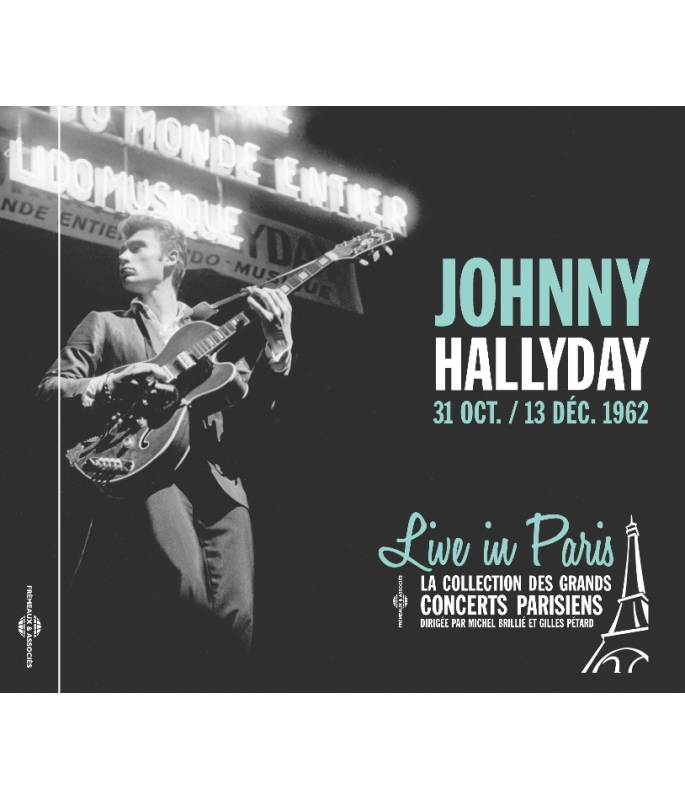
31 Oct. / 13 Déc. 1962
Johnny Hallyday est sans aucun doute, dans l’imaginaire collectif français, l’artiste rock le plus important du XXe siècle.
Ces enregistrements live du jeune rocker, alors âgé de 19 ans, traduisent l’énergie, l’audace et le talent de Johnny, et s’inscrivent dans la pure veine du pur rock n’ roll du début de sa carrière.
La rédaction du livret a été réalisée par François Jouffa, biographe de l’icône, et permet de restituer dans son contexte l’éclosion de celui qui était devenu en 1962 l’idole des jeunes et qui conservera cette image tout au long de sa carrière.
Patrick FRÉMEAUX
DIRECTION ARTISTIQUE COLLECTION LIVE IN PARIS : GILLES PÉTARD ET MICHEL BRILLIÉ
DROITS : BODY & SOUL - GILLES PETARD
COMMERCIALISATION : FREMEAUX & ASSOCIES
ELLE EST TERRIBLE • L’IDOLE DES JEUNES • C’EST UNE FILLE COMME TOI • DANS UN JARDIN D’AMOUR • PAS CETTE CHANSON • RETIENS LA NUIT • PRÉSENTATION MUSICIENS • HEY BABY • TOUT BAS TOUT BAS • I GOT A WOMAN • JE CHERCHE UNE FILLE / LAISSE LES FILLES / KILI WATCH • 24.000 BAISERS • LAISSEZ NOUS TWISTER • NOUS QUAND ON S’EMBRASSE • L’IDOLE DES JEUNES.
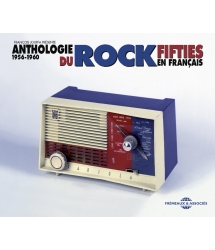
HENRI SALVADOR, JEAN YANNE, MAGALI NOEL, EDDIE...
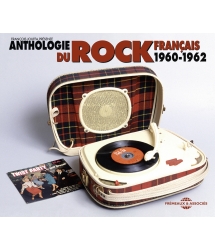
EDDY MITCHELL, JOHNNY HALLYDAY, DICK RIVERS…
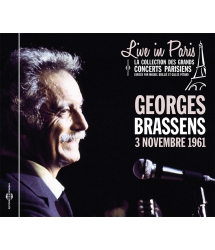
LIVE IN PARIS (3 NOVEMBRE 1961)
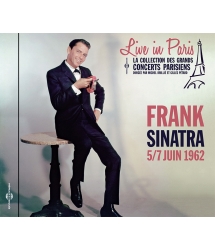
5/7 Juin 1962




-
PisteTitreArtiste principalAuteurDuréeEnregistré en
-
1Elle est terribleJohnny Halliday and The Golden StarsBob Cochran00:01:571962
-
2L'idole des jeunesJohnny Halliday and The Golden StarsRalph Bernett00:02:391962
-
3C'est une fille comme toiJohnny Halliday and The Golden StarsNicolas Perrou00:01:441962
-
4Dans un jardin d'amourJohnny Halliday and The Golden StarsFrancis Alan Pitney Eugene00:02:261962
-
5Pas cette chansonJohnny Halliday and The Golden StarsBetty King00:02:351962
-
6Retiens la nuitJohnny Halliday and The Golden StarsCharles Aznavour00:03:231962
-
7Présentation des musiciensJohnny Halliday and The Golden StarsJohnny Halliday00:01:021962
-
8Hey BabyJohnny Halliday and The Golden StarsMaurice Teze00:02:171962
-
9Tout bas, tout basJohnny Halliday and The Golden StarsG.D. Weiss00:02:471962
-
10I Got A WomanJohnny Halliday and The Golden StarsRay Charles00:05:531962
-
11Je cherche une fille/Laisse les filles/Kili WatchJohnny Halliday and The Golden StarsG. Derse00:02:041962
-
1224000 BaisersJohnny Halliday and The Golden StarsFulci00:02:181962
-
13Laissez-nous TwisterJohnny Halliday and The Golden StarsS. Cooke00:02:401962
-
14Nous quand on s'embrasseJohnny Halliday and The Golden StarsR. Hargrave00:02:501962
-
15L'idole des jeunesJohnny Halliday and The Golden StarsSam M. Lewis00:02:531962
Johnny Halliday
JOHNNY HALLYDAY
31 oct. / 13 déc. 1962
Live in Paris
La collection des grands concerts parisiens
Dirigée par Michel Brillié et Gilles Pétard
Johnny Hallyday
LIVE IN PARIS
31 octobre / 13 décembre 1962
1962 : l’année où Johnny Hallyday est devenu l’Idole des jeunes.
Par François JOUFFA
Johnny Hallyday, malgré son jeune âge en 1962, n’est pas en début de carrière. Né en 1943, il n’a pas encore 20 ans mais son parcours professionnel est déjà très riche d’expériences car il est présent pendant les spectacles de ses cousins Desta et Lee, les «?Halliday’s Dancers?» (avec un i) à partir de l’âge de 3 ans. Sur toutes les scènes d’Europe. Jean-Philippe, véritable «?enfant de la balle?», chante derrière un micro (du répertoire de Georges Brassens, notamment) sous le nom d’artiste Johnny Hallyday depuis l’âge de 10 ans. À la demande de sa tante, une ancienne actrice du cinéma muet, c’est l’illustre Maurice Chevalier qui lui donne ses premiers conseils d’artiste adolescent. On connaît des (bons) enregistrements de Johnny dès l’âge de 15 et 16 ans. Sa révélation publique parisienne date de septembre 1960 quand il assure, dans un chahut indescriptible entre admirateurs et destructeurs, la première partie de l’humoriste Raymond Devos à l’Alhambra. Son premier disque, un super 45 tours avec quatre chansons, avait été enregistré, pour la firme Vogue, spécialiste de jazz, six mois plus tôt. Johnny est, dorénavant, encadré par un vrai manager, Johnny Stark, qui l’impose vite comme une star en devenir. L’Olympia lui ouvre ses portes, en vedette, le 20 septembre 1961. Son directeur Bruno Coquatrix, d’abord réticent au nouveau phénomène, est si enthousiaste après le spectacle qu’il l’embrasse en oubliant d’ôter son cigare. Un an plus tard, en octobre 1962, il y chante -consécration !- pendant six semaines. Dix-huit chansons sont à son programme. Soit cinquante-quatre chansons et trois ballets chaque dimanche, puisque Johnny s’y produit, en sueur, pendant deux matinées et une soirée. Entre parenthèses, c’est aussi à l’Olympia, dans les coulisses d’un spectacle de l’idole anglaise Vince Taylor, que Johnny croise le regard de Sylvie Vartan, le couple devenant ensuite, pour des décennies, les premiers «?people?» de la presse magazine française. Quand le jeune artiste (19 ans) repasse à l’Olympia, sa nouvelle maison de disques, Philips, l’avait envoyé enregistrer un album 33 tours aux USA, à Nashville (titré bizarrement «?Johnny à New York?»), bénéficiant des Jordanaires, les choristes légendaires d›Elvis Presley. Elvis ! Le King, le roi jamais indétrôné du rock & roll ! Mais, à cette époque, au début des années 1960, tout allant très vite dans l’histoire de la musique populaire, après une incorporation obligatoire sous les drapeaux de l’Oncle Sam et un service miliaire en Allemagne occupée par les forces alliées, Elvis avait vu sa couronne menacée par des plus jeunes aux répertoires plus sucrés et plus consensuels, pour les parents et les médias, que le rock scandaleux qui avait emprunté son blues aux artistes noirs, sans parler de ses coups de bassins lascifs. Le show-business américain tenta donc (et réussit) d’imposer une génération de minets chanteurs, plus calmes, parfaits gendres idéaux. Parmi eux, le beau Ricky Nelson dont Elvis, lui-même, disait : «?Si James Dean avait pu chanter, il aurait sonné comme la voix de Ricky?». Johnny, fan énamouré de James Dean dont les poses photographiques l’inspiraient, Johnny, fan absolu d’Elvis Presley dont il avait chanté (en anglais) les classiques du rock dès son âge tendre, Johnny Hallyday se devait d’adapter le tube international de Ricky Nelson en français. C’est ainsi que «?Teenage Idol?» par Ricky Nelson devient «?L’Idole des jeunes?» dans la bouche de Johnny (texte de Ralph Bernet). Un titre qui lui collera à la peau toute sa vie, qu’il interprète -bien sûr- à chacun de ses deux passages à Olympia en 1962 (le deuxième, celui du 13 décembre, était un gala au profit des enfants nécessiteux), et qu’il reprendra devant soixante mille personnes pour le show de l’anniversaire de ses 50 ans au Parc des Princes parisien. 1962, c’est aussi et surtout l’année des violences juvéniles (annonciatrices des événements futurs de Mai 68) suscitées par les concerts de rock, surtout ceux de Johnny : salle de spectacle du théâtre de Verdure entourée par les CRS à Tarbes, interdiction municipale à Cannes et dans les arènes de Bayonne, casino d’Aix-en-Provence saccagé par les fans excités, etc. Il était temps, pour le showbiz français, comme précédemment pour l’américain, de canaliser ce mouvement rock qui inquiète tant les autorités et les éducateurs. Ce sera la création et le lancement de dizaines de chanteurs proprets et gentillets, dits yéyé, souvent sans saveur, très jeunes idoles d’une ou deux saisons seulement, dans le sillage de Sheila ou de Claude François. Un mouvement musical mais surtout un fait de société amplifié par l’émission de radio Salut les Copains sur Europe n°1, animé par Daniel Filipacchi (plus de dix millions d’auditeurs), et relayé par le mensuel du même nom, SLC (au tirage d’un million d’exemplaires) dont le premier numéro sort, justement, pendant cette année 1962 (en juillet-août, au prix de 1 nouveau franc 50). Avec qui en couverture ? Johnny Hallyday. Toutefois, malgré quelques rares concessions, dont des enregistrements de twist qu’il détestait, Johnny conservera intacte, pendant toute son existence, son image première, celle de la «?rock attitude?», celle d’un homme au cœur de rocker, pur et dur, tatoué, traversant toutes les décennies en haut de l’affiche, passant avec succès le changement de siècle et de millénaire. L’artiste a, maintenant, plus de 70 ans, et, pourtant, il est fréquent qu’un journal utilise encore (et toujours) l’expression «?Idole des jeunes?» pour qualifier ce chanteur qui n’a jamais pris sa retraite.
François Jouffa, auteur de Johnny Story, Éditions de France, 1975?; Idoles Story, Éditions Alain Mathieu, 1978?; L’Âge d’or du yéyé, Éditions Ramsay, 1980?; Johnny 50 ans, Éditions Michel Lafon, 1992?; Johnny 60 ans, Éditions l’Archipel, 2002?; Génération Johnny, Éditions Gründ, 2010.
© FRÉMEAUX & ASSOCIÉS 2015
Johnny Hallyday
LIVE IN PARIS
October 31 / December 13, 1962
1962 — The Year Johnny Hallyday Became The Teenage Idol.
By François JOUFFA
Johnny Hallyday, despite being in his teens in 1962, was not really a beginner. Born in 1943, he already had a great deal of professional experience behind him: by the time he was 3 he was already a feature of the shows given by his cousins Desta and Lee (the “Halliday’s Dancers”, spelt with an “i”); by the age of 10, Jean-Philippe (his real name) was a genuine “trouper” familiar with a microphone, singing under the name “Johnny Hallyday” (particularly Georges Brassens songs); and it was his aunt, an actress in the days of the silent screen, who asked the illustrious Maurice Chevalier, no less, to give the adolescent his first artistic advice. Johnny was already making (good) recordings when he was 15 or 16, in fact, and was discovered by Parisian audiences in September 1960 when, to a tumultuous reception from arguing admirers and detractors, he took the stage to play the opening act of a concert at the Alhambra before the appearance of featured humorist Raymond Devos. He’d already made his first record, a “Super 45” with four songs, six months earlier, for Vogue, a label which specialized in jazz. From then on, Hallyday would have the benefit of a real manager, Johnny Stark, who quickly established his protégé as an up-and-coming Star. On 20th September 1961, the Olympia opened its doors to him as the main attraction; the famous theatre’s director, Bruno Coquatrix, had been reticent at first, but after the show he was so enthusiastic about the new phenomenon that he forgot to remove his cigar when he embraced him. A year later, in October 1962, Hallyday moved into the Olympia for a full six weeks: consecration!
Eighteen songs in all, but in fact this meant 54 songs and 3 ballets every Sunday, because Johnny was booked to appear, soaked in sweat, for two matinees in addition to the evening show. Incidentally, the Olympia was also the scene of Johnny’s first historic meeting with Sylvie Vartan (in the wings, during a show by the British idol Vince Taylor); they would become a “couple” (for decades), the very first “People” in the French tabloids. By the time the 19 year-old Hallyday returned to the Olympia in 1962, his new record-company, Philips, had already sent him to America, to record a 12” LP in Nashville (strangely entitled “Johnny à New York”) with the aid of The Jordanaires, Elvis Presley’s legendary back-up singers. Elvis! The King of Rock & Roll! And still on his throne. But in those days, early in the Sixties, everything was moving fast in the world of popular music. After being drafted into the Army of Uncle Sam to serve the flag in Germany with the Allied forces, Elvis had seen his crown threatened by younger artists whose repertoire was softer, more acceptable to American parents and media than that scandalous Rock which borrowed its blues from black artists, not to mention a lewd swaying of the pelvis… American show-business attempted, (successfully), to impose a generation of teen-singers: they were calmer, perfect sons-in-law. Among them was the handsome Ricky Nelson, of whom Elvis once said, “If James Dean had been able to sing, he would have sounded like Ricky.” Johnny loved James Dean, whose poses for photographers inspired him; Johnny was also an absolute fan of Elvis Presley, whose rock classics he’d been singing (in English) ever since he was a boy; and Johnny Hallyday just had to adapt Ricky Nelson’s international hit as a French song. And so Ricky Nelson’s “Teenage Idol” became “L’Idole des jeunes” by Johnny, with lyrics by Ralph Bernet. The title would stick with Hallyday for the rest of his life, and he would sing the song — of course — at both his Olympia appearances in 1962 (the second, on December 13th, was a benefit concert for children in need.) Hallyday would pick up the song again, this time for an audience of 60,000 when he gave his 50th birthday concert at the Parc des Princes stadium in Paris. 1962 was also the year when young people in France began rioting (heralding the events of May 1968) at rock concerts, especially those with Johnny on the bill: in Tarbes, the Théâtre de Verdure was surrounded by CRS riot-police; in Cannes and in the arenas of Bayonne, his concerts were banned; and the Casino in Aix-en-Provence was torn up by excited fans… the list was long. It was time for French showbiz — as for America earlier — to control that rock movement which authorities, teachers and youth-workers found so worrying. The result was the creation and launching of dozens of “nice”, clean-shaven young people who became known in France as “YéYé” singers. Often insipid in taste, they became young idols themselves, for one or two years at most, following in the wake of artists like Sheila or Claude François. It was a music movement, but above all a society-phenomenon amplified by the radio programme called “Salut les Copains” (on the Europe N°1 station) presented by Daniel Filipacchi. It had ten million listeners… The show was echoed by a monthly magazine of the same name, shortened to SLC, with a print-run of one million; its first issue appeared at newsagents in… 1962 (the July-August summer issue, with a cover-price of 1 Franc 50.) Who was on the cover? Johnny Hallyday. Even so, and despite a few rare concessions (among them some “Twist” recordings which he hated), Johnny would keep his first image intact throughout his existence, his “rock attitude” image, that of a man with the heart of a rocker, pure to the core, and with a tattoo to prove it, cutting across decades at the top of the bill and, in the end, successfully negotiating the turn of a century and the millennium. Hallyday the artist is now aged 70; but it still happens that a newspaper will use (again and again) the phrase “Idole des jeunes” in reference to this singer who has never retired.
François Jouffa, author of Johnny Story (Éditions de France, 1975), Idoles Story (Éditions Alain Mathieu, 1978), L’Âge d’or du yéyé (Éditions Ramsay, 1980), Johnny 50 ans (Éditions Michel Lafon, 1992), Johnny 60 ans (Éditions l›Archipel, 2002) and Génération Johnny (Éditions Gründ, 2010).
© FRÉMEAUX & ASSOCIÉS 2015
1. Elle est terrible (Jil et Jan / Eddie Cochran - Eddie Cochran / Sharon Sheeley /Bob Cochran) 1’57
2. L’idole des jeunes (Ralph Bernet / Sam M Lewis - Sam M Lewis) 2’39
3. C’est une fille comme toi (Nicolas Perrou / Noel Roux - Georges Garvarentz) 1’44
4. Dans un jardin d’amour (Gilbert Guenet / Jan / Gene Pitney - Gene Pitney) 2’26
5. Pas cette chanson (Ralph Bernet - Ahmed Ertergun / Betty King) 2’35
6. Retiens la nuit (Charles Aznavour - Georges Garvarentz) 3’23
7. Présentation musiciens 1’02
8. Hey Baby (Maurice Tézé / Margaret Cobb / Bruce Channel - Margaret Cobb / Bruce Channel) 2’17
9. Tout bas tout bas (Georges Garvarentz / Clément Nicolas - George David Weiss / Aaron Harold Schroeder) 2’47
10. I Got a Woman (Ray Charles) 5’53
11. Je cherche une fille / Laisse les filles / Kili Watch (Jil & Jan / Gus Derse - Gilbert Guenet / Johnny Hallyday / Gus Derse) 2’04
12. 24.000 baisers (Fernand Bonifay-Fulci / Vivarelli / Adriano Celentano) 2’18
13. Laissez nous twister (André Pascal / Sam Cooke - Sam Cooke) 2’40
14. Nous quand on s’embrasse (Jil et Jan / Jerry Lee Lewis / Ron Hargrave - Jerry Lee Lewis / Ron Hargrave) 2’50
15. L’idole des jeunes (Ralph Bernet / Sam M Lewis - Sam M Lewis) 2’53
Total Time 39’28
Recorded by: Europe N°1 Technical Staff
Recording dates
Tracks 1 to 10: October 31, 1962
Tracks 11 to 15: December 13,1962
Recording place
Olympia Theater, Paris, France
Personnel
Johnny Hallyday (Vocals, Guitar)
The Golden Stars:
Louis Belloni (Drums)
Marc Hemmler (Electric Piano, Organ)
Jean Tosan (Tenor sax)
Claude “Robbins” Djaoui (Lead Guitar)
Antonio Rubio (Bass Guitar)
Orchestre de l’Olympia Daniel Janin, direction
Produced by: Bruno Coquatrix, Johnny Stark & Lucien Morisse
Dedicated to Claude Boquet, Bill Dubois, Jean Claude, Philippe Moch and the gang
La collection Live in Paris:
Collection créée par Gilles Pétard pour Body & Soul et licenciée à Frémeaux & Associés
Direction artistique et discographie: Gilles Pétard et Michel Brillié
Fabrication et distribution: Frémeaux & Associés
Johnny Hallyday est sans aucun doute, dans l’imaginaire collectif français, l’artiste rock le plus important du XXe siècle. Ces enregistrements live du jeune rocker, alors âgé de 19 ans, traduisent l’énergie, l’audace et le talent de Johnny, et s’inscrivent dans la pure veine du pur rock n’ roll du début de sa carrière. La rédaction du livret a été réalisée par François Jouffa, biographe de l’icône, et permet de restituer dans son contexte l’éclosion de celui qui était devenu en 1962 l’idole des jeunes et qui conservera cette image tout au long de sa carrière.
Patrick FRÉMEAUX
La collection Live in Paris, dirigée par Michel Brillié, permet de retrouver des enregistrements inédits (concerts, sessions privées ou radiophoniques), des grandes vedettes du jazz, du rock & roll et de la chanson du XXe siècle. Ces prises de son live, et la relation avec le public, apportent un supplément d’âme et une sensibilité en contrepoint de la rigueur appliquée lors des enregistrements studios. Une importance singulière a été apportée à la restauration sonore des bandes, pour convenir aux standards CD tout en conservant la couleur d’époque.
Patrick FRÉMEAUX & Gilles PÉTARD
Johnny Hallyday. There’s no doubt in the minds of the French: he is the most important rock artist of the 20th century. He was just 19 when he made these live recordings which translate every kilo of the talent, energy and daring which the young rocker was putting into his career debuts: pure rock ‘n’ roll. The enclosed booklet was written by François Jouffa, the icon’s biographer, and it details the arrival on the scene of the Star who became the “Teenage Idol” in 1962… and kept that image throughout his career.
Patrick FRÉMEAUX
The Live in Paris collection by Michel Brillié allows listeners to hear previously-unreleased recordings (made at concerts and private- or radio-sessions) by the great 20th stars in jazz, rock & roll and song. These “live” takes, and the artists’ rapport with their audiences, gives these performances an additional soul and sensibility in counterpoint to the rigorous demands of studio recordings. Particular care was taken when restoring the sound of these tapes in order to meet CD standards while preserving the original colours of the period.
Patrick FRÉMEAUX & Gilles PÉTARD
CD Johnny Halliday 31 oct./13 déc. 1962 Live in Paris, la collection des grands concerts parisiens, Johnny Halliday © Frémeaux & Associés 2015
